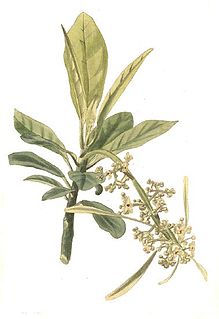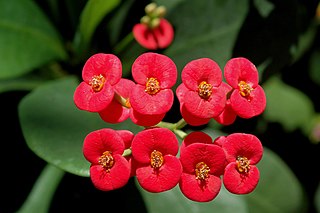
Omphalea is a plant genus of the family Euphorbiaceae first described as a genus in 1759. It is native to tropical parts of the Americas, the West Indies, Asia, Australia, and Africa.
Claoxylopsis is a plant genus of the family Euphorbiaceae, first described as a genus in 1939. The entire genus is endemic to Madagascar.
- Claoxylopsis andapensisRadcl.-Sm.
- Claoxylopsis perrieriLeandri
- Claoxylopsis purpurascensRadcl.-Sm.
Amyrea is a plant genus of the family Euphorbiaceae first described as a genus in 1941. It is native to Madagascar and to nearby Mayotte Island in the Indian Ocean.
Argomuellera is a genus of plant of the family Euphorbiaceae first described as a genus in 1894. It is native to sub-Saharan Africa, Madagascar, and the Comoros Islands.
Benoistia is a genus of shrubs or trees of the spurge family (Euphorbiaceae) and the monotypic subtribe Benoistiinae. It was first described as a genus in 1939. The entire genus is endemic to Madagascar.
- Benoistia orientalisRadcl.-Sm. - N + E Madagascar
- Benoistia perrieriH.Perrier & Leandri - Madagascar
- Benoistia sambiranensisH.Perrier & Leandri - N Madagascar
Cladogelonium is a monotypic plant genus of the family Euphorbiaceae first described as a genus in 1939.
Leptonema is a genus of flowering plant belonging to the family Phyllanthaceae first described in 1824. The entire genus is endemic to Madagascar.
- Leptonema glabrum(Leandri) Leandri
- Leptonema venosum(Poir.) A.Juss.
Keayodendron is a genus of plants in the family Phyllanthaceae first described as a genus in 1959. It contains only one known species, Keayodendron bridelioides, native to tropical western and Central Africa.

Securinega is a genus of plants in the family Phyllanthaceae, first described as a genus in 1789. As presently conceived, the genus is native to Madagascar and the Mascarene Islands in the Indian Ocean. In the past, it was considered to be much more widespread, thus explaining the long list of species formerly included.
- Securinega antsingyensisLeandri - W Madagascar
- Securinega capuroniiLeandri - W Madagascar
- Securinega durissimaJ.F.Gmel. - Madagascar, Mauritius, Réunion, Rodrigues Island
- Securinega perrieriLeandri - W Madagascar
- Securinega seyrigiiLeandri - W Madagascar
Lingelsheimia is a plant genus variously classified in the families Putranjivaceae or Phyllanthaceae, first described as a genus in 1909. It is native to central Africa and Madagascar.
- Lingelsheimia abbayesii(Leandri) Radcl.-Sm. - Madagascar
- Lingelsheimia ambigua(Leandri) Radcl.-Sm. - Madagascar
- Lingelsheimia fiherenensis(Leandri) Radcl.-Sm. - Madagascar
- Lingelsheimia frutescensPax - Gabon, Zaire
- Lingelsheimia manongarivensis(Leandri) G.L.Webster - Madagascar
- Lingelsheimia sylvestris(Radcl.-Sm.) Radcl.-Sm. - Tanzania

Euphorbia milii, the crown of thorns, Christ plant, or Christ thorn, is a species of flowering plant in the spurge family Euphorbiaceae, native to Madagascar. The species name commemorates Baron Milius, once Governor of Réunion, who introduced the species to France in 1821. It is imagined that the species was introduced to the Middle East in ancient times, and legend associates it with the crown of thorns worn by Christ. It is commonly used as an ornamental houseplant that can be grown in warmer climates. The common name is due to the thorns and deep red bracts referring to the crown thorn Jesus had to wear during his crucification and his blood.
Euphorbia pellegrinii is a species of plant in the family Euphorbiaceae. It is endemic to Madagascar. Its natural habitat is subtropical or tropical dry lowland grassland. It is threatened by habitat loss.

Laportea is a genus of plants in the family Urticaceae. They are herbaceous, either annual or perennial. Like many plants of the Urticaceae, they have stinging hairs. There are stinging and non-stinging hairs on the same plant. The genus was named after the French naturalist Francis de Laporte de Castelnau.

Treculia is a genus of trees in the plant family Moraceae that is native to west and central Africa and Madagascar. The best-known member of the genus, Treculia africana, commonly known as the African breadfruit, is used as a food plant.
Jacques Désiré Leandri, born 1903 in Corsica, died 1982, was a French botanist and mycologist.
Paul Auguste Danguy was a French botanist.
Wielandia elegans is a species of flowering plants, of the family Phyllanthaceae. It is found on Aldabra, Seychelles, Comoros and Madagascar.
Synaptolepis is a genus of flowering plants belonging to the family Thymelaeaceae.
Capuronia is a genus of flowering plants belonging to the family Lythraceae.




